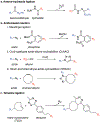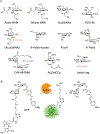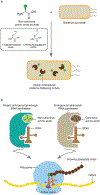Shedding Light on Bacterial Physiology with Click Chemistry
- PMID: 37841997
- PMCID: PMC10569449
- DOI: 10.1002/ijch.202200064
Shedding Light on Bacterial Physiology with Click Chemistry
Abstract
Bacteria constitute a major lifeform on this planet and play numerous roles in ecology, physiology, and human disease. However, conventional methods to probe their activities are limited in their ability to visualize and identify their functions in these diverse settings. In the last two decades, the application of click chemistry to label these microbes has deepened our understanding of bacterial physiology. With the development of a plethora of chemical tools that target many biological molecules, it is possible to track these microorganisms in real-time and at unprecedented resolution. Here, we review click chemistry, including bioorthogonal reactions, and their applications in imaging bacterial glycans, lipids, proteins, and nucleic acids using chemical reporters. We also highlight significant advances that have enabled biological discoveries that have heretofore remained elusive.
Keywords: Bacteria; Bioorthogonal chemistry; Click chemistry; Fluorescent probes; Imaging.
Figures






Similar articles
-
Azide-based bioorthogonal chemistry: Reactions and its advances in cellular and biomolecular imaging.Biophys Rev (Melville). 2021 May 25;2(2):021301. doi: 10.1063/5.0050850. eCollection 2021 Jun. Biophys Rev (Melville). 2021. PMID: 38505123 Free PMC article. Review.
-
Bioorthogonal chemical reporters for analyzing protein lipidation and lipid trafficking.Acc Chem Res. 2011 Sep 20;44(9):699-708. doi: 10.1021/ar200063v. Epub 2011 Jun 15. Acc Chem Res. 2011. PMID: 21675729 Free PMC article.
-
Click chemistry and bioorthogonal reactions: unprecedented selectivity in the labeling of biological molecules.Biochemistry. 2009 Jul 21;48(28):6571-84. doi: 10.1021/bi9007726. Biochemistry. 2009. PMID: 19485420 Review.
-
Recent Advances in Bioorthogonal Click Chemistry for Enhanced PET and SPECT Radiochemistry.Bioconjug Chem. 2023 Mar 15;34(3):457-476. doi: 10.1021/acs.bioconjchem.2c00583. Epub 2023 Feb 22. Bioconjug Chem. 2023. PMID: 36811499 Review.
-
Protein click chemistry and its potential for medical applications.Q Rev Biophys. 2024 Apr 15;57:e6. doi: 10.1017/S0033583524000027. Q Rev Biophys. 2024. PMID: 38619322 Review.
Cited by
-
Selective Glycan Labeling of Mannose-Containing Glycolipids in Mycobacteria.J Am Chem Soc. 2024 Jan 10;146(1):377-385. doi: 10.1021/jacs.3c09495. Epub 2023 Dec 19. J Am Chem Soc. 2024. PMID: 38112296 Free PMC article.
References
Grants and funding
LinkOut - more resources
Full Text Sources
